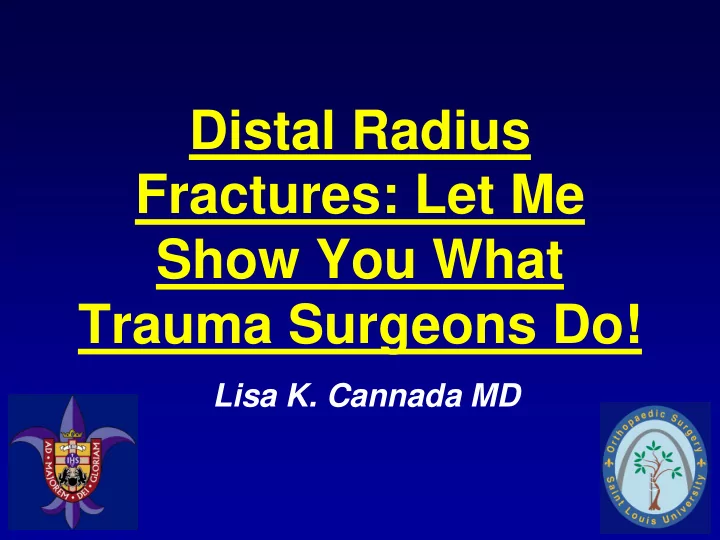

Distal Radius Fractures: Let Me Show You What Trauma Surgeons Do! Lisa K. Cannada MD
Disclosures • No pertinent disclosures • Member: – AAOS Board of Directors – MAOA Board of Directors – OTA Committee Member
Etiology
Etiology
Etiology
Who Did This?
Trauma or Hand 26%
Trauma or Hand
Trauma or Hand
Trauma or Hand
Trauma or Hand
Trauma or Hand
Treatment Goals & Considerations
Factors to Consider • Age • Dominance • Demand • Additional Injuries • Medical co-morbidities
What Does This Mean? 4685 11/22/17
Treatment Options • Nonoperative • Percutaneous pinning • External fixation • ORIF • Combination • Adjuncts
Before You Start
Treatment • Kwire fixation – Acceptable CR – Give subchondral support – May unload joint with Ex Fix
External Fixation • Don’t throw away the ex fix! • Fractures with metaphyseal comminution • Open fractures • Polytrauma patient • In combination with other treatments
Pin Placement Proximally: Open incision Between ECRL and Identify SRN ECRB
Ex Fix
Ex Fix
Case Example
“Regular” Plating
“Regular” Plating
Know Your Plate
Volar Approach • Identify landmarks • Find FCR • Can extend into carpal tunnel if necessary
Volar Approach • Incise FCR volar sheath • Identify radial artery
Volar Approach • Retract FCR ulnarly • Then incise FCR dorsal sheath • Pronator quadratus identified
Volar Approach • Incise pronator quadratus • Avoid radiocarpal joint arthrotomy Tip: Can release brachioradialis for styloid exposure
Volar Approach
Getting the reduction…
Reduce & Hold Before Plating…
Radiographic Evaluation • Pronated Oblique View • Dorsal Tangential View
Dorsal Plating
Always Evaluate the DRUJ
Always be prepared…
Surprise!!!
Trauma or Hand 20%
Trauma or Hand
Trauma or Hand 59% , 23%
Trauma or Hand 59%
Summary • There is no gold standard for treatment or fixation • Maintain many “tools” in your armamentarium
Thank You! Lcannada@slu.edu
Recommend
More recommend